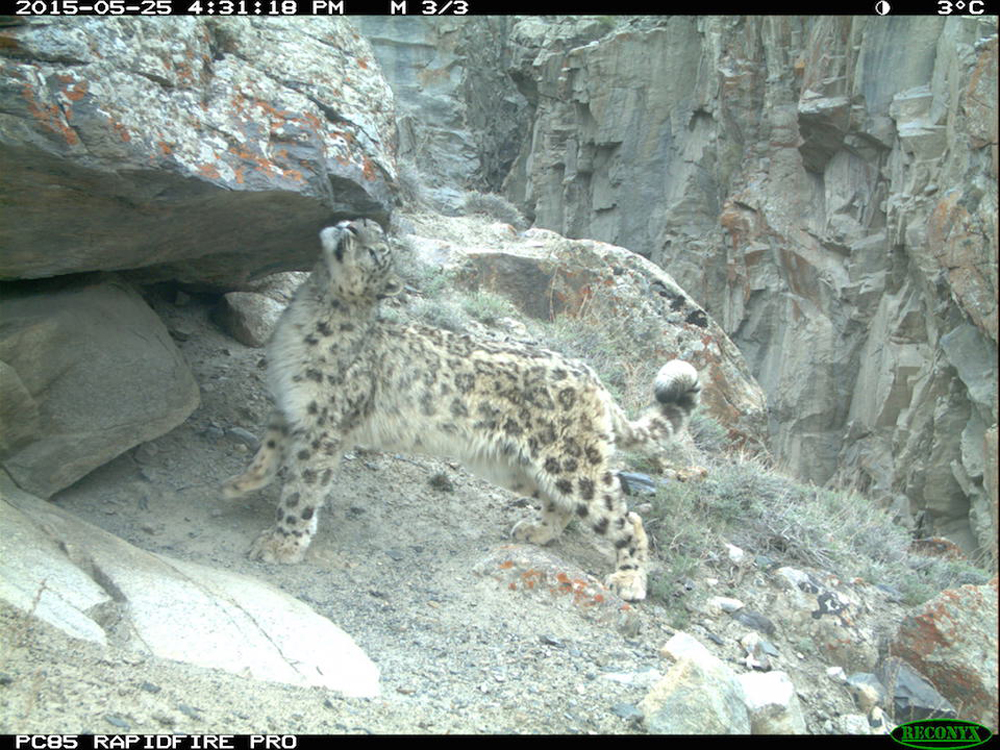Micro Porcupines to Snow Leopards: WCS's Favorite Wildlife Photos of 2015


Stephen Sautner is WCS executive director of communications; Max Pulsinelli is director of communications for WCS's zoos and aquarium; Julie Larsen Maher is staff photographer for the WCS and the first woman to hold the position since the society's founding in 1895. In addition to documenting conservation work in some of WCS' 500 field programs in 60 countries around the world, Maher photographs animals and events at WCS' five New York-based wildlife parks: the Bronx Zoo, Central Park Zoo, New York Aquarium, Prospect Park Zoo and Queens Zoo. The authors contributed this article to Live Science's Expert Voices: Op-Ed & Insights.
Each year, the Wildlife Conservation Society — which protects wildlife and habitats in nearly 60 nations and the world's oceans — compiles a list of its favorite wildlife images out of the literally thousands our scientists capture from camera traps and field work. Then, we add the best images from our flagship Bronx Zoo, where we're headquartered, with images coming from staff photographer Julie Larsen Maher (whose Live Science photo essays have featured animals from spiders to hippos).
Our favorite wildlife photos for 2015 come from far-flung corners of the planet, such as the Hindu Kush Mountains of Afghanistan, home of the elusive snow leopard, and Bolivia's Madidi National Park, where a new species of frog was discovered earlier this year. The zoo images are our picks for the best shots representing new animals, notable animal births and exhibit openings.
A serious "cute" factor is well-represented, from a baby gorilla riding mom's back to an adorable baby porcupine from the Bronx Zoo's newly renovated Children's Zoo. Together, all of the images represent the incredible, often beautiful, and diverse wildlife found throughout the planet — and underscore the need to protect them.
You can see the 2015 WCS favorite images below, and some of our top galleries for Live Science in Elusive Siberian Tigers Captured in Brilliant Images, Bad-Rap Bats in Danger of Extinction Around the World and 8 Baby Turtles and Tortoises: Cute, and Critically Endangered.
From the zoo
Prickly pup
This North American porcupine pup was born at the Bronx Zoo's Children's Zoo shortly after it reopened after undergoing extensive renovations. (Credit: Julie Larsen Maher © WCS)
Get the world’s most fascinating discoveries delivered straight to your inbox.
Stand-ins save a life
A pair of lesser adjutant storks served as surrogate parents to a chick hatched from an abandoned egg. This pair raised the chick along with one of their own. (Credit: Julie Larsen Maher © WCS)
A teaching moment
An Asian small-clawed otter alongside a pup born at the Bronx Zoo's JungleWorld in the summer of 2015. (Credit: Julie Larsen Maher © WCS)
Colorful spectacle
A scarlet macaw flies over Astor Court in front of the Bronx Zoo's historic Zoo Center during a free-flight bird show. (Credit: Julie Larsen Maher © WCS)
Baby-time
An adult female gelada baboon carries her baby on her back in the Bronx Zoo's Baboon Reserve. This was the first gelada born at the Bronx Zoo in 13 years. The Bronx Zoo is the only zoo in the U.S. to exhibit the species. (Credit: Julie Larsen Maher © WCS)
Home in the cold
The Bronx Zoo's Aquatic Bird House is home to a colony of little blue penguins. This was a new species for the zoo in 2015. (Credit: Julie Larsen Maher © WCS)
Piggy-backing it
The Bronx Zoo welcomed two baby western lowland gorillas in 2015. This youngster is content to hitch a ride on his mom's back. (Credit: Julie Larsen Maher © WCS)
A mother's love
An adult female western lowland gorilla holds her baby in Congo Gorilla Forest. (Credit: Julie Larsen Maher © WCS)
Cuteness overload
Squirrel monkeys at the newly renovated Bronx Zoo's Children's Zoo. (Credit: Julie Larsen Maher © WCS)
Welcome to the family
This giant anteater is one of the new species added to the Children's Zoo in 2015. (Credit: Julie Larsen Maher © WCS)
In the wild
Cute and tiny
A Fito leaf chameleon, one of many species found exclusively on the island of Madagascar. (Credit: Felx Ratelolahy/WCS)
Timid and adorable
A shy-looking Asian elephant caught by a camera trap in Huai Kha Khaeng Wildlife Sanctuary in Thailand. (Credit: Dept. of National Parks, Wildlife and Plant Conservation and WCS Thailand Program)
Unexpected company
In Shimla District, Himachal Pradesh, India, this leopard is a regular backyard visitor. (Credit: WCS-India/Himachal Pradesh Forest Department)
Scratching an itch
A snow leopard rubs up for a great camera-trap pic in the Hindu Kush Mountains in the Wakhan Corridor of Badakhshan Province. (Credit: WCS Afghanistan)
Saying hello
A lowland tapir camera-trapped by WCS Ecuador, from Arajuno and Villano, in the Amazon. (Credit: WCS Ecuador Program)
Chillin' out
A puma relaxing on the ground in the Ecuadorian Amazon. (Credit: WCS Ecuador Program)
Taking a walk
A giant armadillo (Priodontes maximus) captured by a camera trap in the Ecuadorian Amazon. (Credit: WCS Ecuador Program)
Catnapping
A jaguar rests in a treetop in the flooded forest of Brazil's Mamiraua Sustainable Reserve. (Credit: Carlos Durican/WCS Brazil)
Taking care of their own
A WCS scientist surveys coral reefs in Madagascar's first community-led Marine Protected Areas near Nosy Be. (Credit: Emily Darling/WCS)
Joining the family
Not just any old frog, this is a new species discovered this year during WCS's Identidad Madidi expedition. (Credit: Mileniusz Spanowicz WCS)
Follow all of the Expert Voices issues and debates — and become part of the discussion — on Facebook, Twitter and Google+. The views expressed are those of the author and do not necessarily reflect the views of the publisher. This version of the article was originally published on Live Science.





















